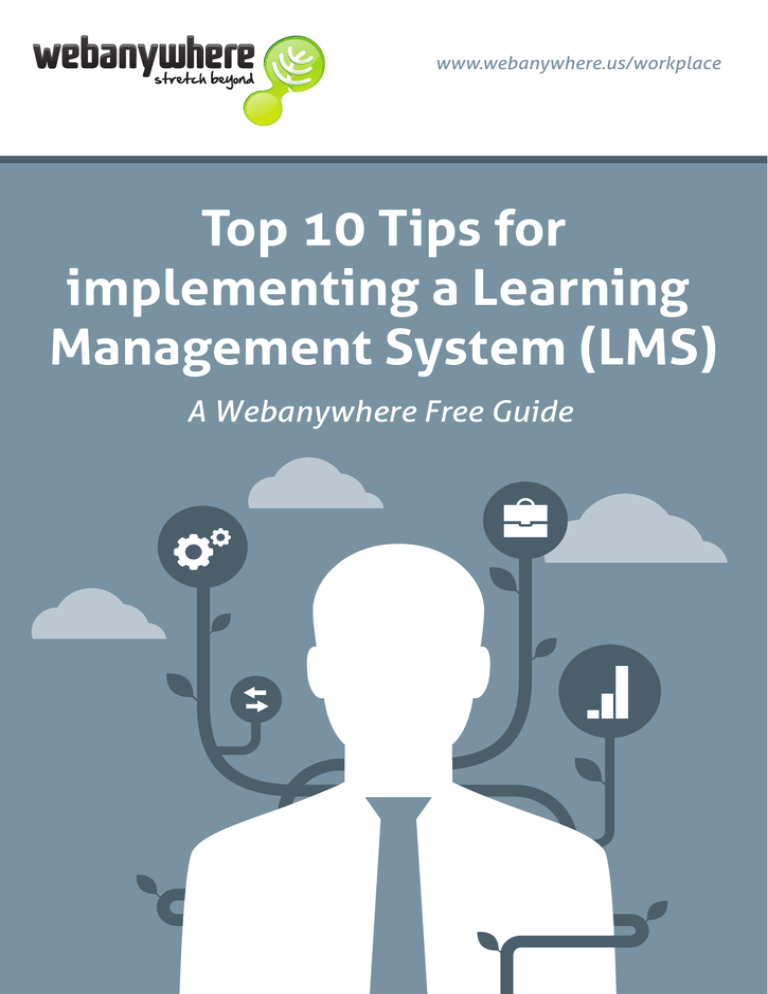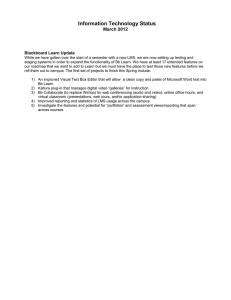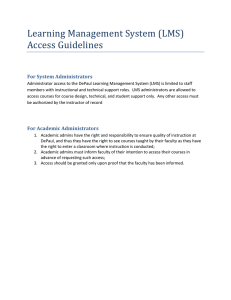
www.webanywhere.us/workplace
Top 10 Tips for
implementing a Learning
Management System (LMS)
A Webanywhere Free Guide
Top 10 Tips for implementing a Learning
Management System (LMS)
A Webanywhere Free Guide
OUR TOP TEN TIPS FOR LMS ADOPTION
Develop an appealing design.
Set up hierarchies correctly (vital for reporting).
Cleanse your user data.
Know the limitations of the LMS!
Be careful with video, think about bandwidth.
Ensure you can assign learning programs ‘easily’.
Check automated tasks are running correctly in the system.
Use ‘roaming’ to understand different learner journeys.
Think about how you will pull data from any legacy systems.
Test, Test - and Test again.
Looking at this list, you’re probably thinking
1. What does all this mean?
2. How do I ensure I don’t go wrong?
Hopefully, after reading the rest of this article you’ll feel more confident!
Learning Management Systems are evolving fast with the incorporation of exciting new plugins such as social
media / talent modules and performance management.
But forget the ‘nice to haves’ for a moment. Often, companies start off on the wrong foot by allowing their LMS
vendor to dictate the project development which stifles creativity.
Before starting, ensure you have a procurement checklist from which to build a set of LMS requirements.
We have developed a document to support you here – just email us for your copy.
So here goes - our Top Ten Tips for LMS Adoption
Telephone: 866 713 0496
workplace@webanywhere.us
www.webanywhere.us
Top 10 Tips for implementing a Learning
Management System (LMS)
A Webanywhere Free Guide
Tip #1 – Design is Everything
If the platform is dull, boring or confusing, people will not use it. An LMS should have ‘kerb appeal’ and be easy
and fun to use. Users will also benefit from a platform that is easy to configure and enables instructional
designers to engage properly with your audience. Learning that is designed for a factory operative will
probably be different to that for a divisional manager.
Tip #2 – Set Up Hierarchies Correctly
Most LMS platforms won’t work properly if consideration hasn’t been made for your learning organisation.
You’ll need to think about how your corporate structure, departmental hierarchies and who needs to manage
individual or groups’ learning objectives. After you’ve established this, you can be assured that learning
content will be assigned correctly and,
Tip #3 – Cleanse your User Data
Continuing on data configuration, you need to consider how data is to be imported or migrated to the LMS.
Typically this is managed using CSV or Excel templates, or integrated HR systems.
In every case it’s critical that duplicates are removed and that the data has been properly cleansed prior to
upload.
Tip #4 - Know the limitations of the LMS
Fourth on our list is to recognise that the LMS won’t be able to resolve all your training challenges overnight!
You need to understand what the system is capable of. For example, if you try to ‘fork’ the software too much
you’ll experience problems when it comes to upgrading (and incur extra costs in doing so...)
Tip #5 - Be careful with video
Using video is becoming the norm for business training. However, using more video will result in an associated
increase (and cost) in bandwidth requirements. If ‘learning on the go’ forms part of your plans, you’ll need to
judge whether employees will actually be able to access your learning videos when out of the office, or if there
are security rules around your corporate firewall which may cause problems with playing the content.
Telephone: 866 713 0496
workplace@webanywhere.us
www.webanywhere.us
Top 10 Tips for implementing a Learning
Management System (LMS)
A Webanywhere Free Guide
Tip #6 - Ensure you can assign learning programs
‘easily’
Ok, so you’ve developed hundreds of great learning modules and uploaded these to your LMS. Now it’s vital
that you’re able to assign these to cohorts of learners easily. In our experience some LMS products are better
than others at achieving this important goal…
Totara LMS, for example, incorporates a Program Management function that enables administrators to achieve
this easily. The ongoing and regular assignment of new or updated learning content can be automated for
groups of users, making your life much easier.
Tip #7 – Test that automated tasks are running
correctly
Within every LMS there will be background system operations continually working away, making sure that
automated tasks such as scheduled reports and email alerts are running. For these tasks – or crons - to work
correctly, your IT department or other specialist support team of IT must ensure that your LMS is configured
correctly.
Tip #8 – Test learner journeys using ‘roaming’
By logging in as different user types (i.e. Manager, Learner, Director, etc) you can begin to consider how
alternative learner journeys could be created in order to deliver the maximum engagement (and therefore best
learning outcomes) for each user type. This process, called roaming, is important to ensure you have achieved
the successful learning design.
Tip #9 – Test your legacy data
Ninth on our list of Top 10 Tips is to thoroughly test and cleanse your legacy data. If you need to migrate from
an existing LMS, you’ll need to bring the data with you.
Don’t wait until two days before the LMS licence subscription renewal date to begin the procurement of a new
LMS - you need to be planning for data migration well in advance. If you leave this too late you are running risk
of (i) the incumbent vendor not releasing your data, and (ii) potentially losing the data. Data needs to be
archived for training records, so try to avoid this risk.
Telephone: 866 713 0496
workplace@webanywhere.us
www.webanywhere.us
Top 10 Tips for implementing a Learning
Management System (LMS)
A Webanywhere Free Guide
Tip #10 - Test, test and test again
The last of our top ten tips for implementing an LMS (and building on the previous three tips!) is to TEST, TEST
and TEST AGAIN. The need for robust quality assurance is probably the most important tip of all.
Think about it - if you were a learner logging into the platform for the first time, and something didn’t work / a
link was broken / an image overlapped, would you have confidence in the system when logging in next time?
Probably not.
Testing is critical to making sure that things are working as expected and should run in parallel with the project
roll out (not just at the end). Think about how you can incorporate test strategies and plans into your roadmap,
make sure it’s regular and documented well.
Conclusion
So, once you’ve established what you need then it’s just a matter of linking your requirements to the ‘right’
LMS solution, right? Well, at first glance most business e-learning platforms might seem to serve your purpose
- but you also need to consider the service design, development and business support processes that the
vendor offers, and most importantly, their track record.
Telephone: 866 713 0496
workplace@webanywhere.us
www.webanywhere.us
The future of course management
Webanywhere specialises in learning technologies that enable the
concepts described in this paper, and stretch the learning potential of an
organisation’s most important asset - its people. To discuss social learning,
multi tenancy or the effective implementation of a learning management
system in your organisation, contact our workplace learning team on 01535
604026, or email workplace@webanywhere.co.uk.
© Webanywhere Limited 2014. All Rights Reserved.
Webanywhere US
210 West Rittenhouse Square
Suite 401,
Philadelphia,
PA, 19103
Tel. 866 713 0496
www.webanywhere.us/workplace
workplace@webanywhere.us
Webanywhere Poland
Klimczoka Business Area
ul. Klimczoka 9
40-857 Katowice
Tel. 32 6304137
Webanywhere UK
Orchard House
Aire Valley Business Centre
Lawkholme Lane
Keighley
West Yorkshire BD21 3BB
Tel. 01535 604026



